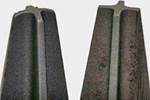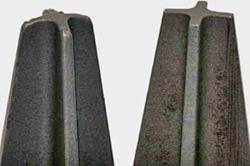The Race to EDM Automation
In order for moldmakers to compete with overseas forces and their huge labor cost advantages, automation is no longer an option...it is a necessity.
When the first manual diesinkers were produced in the mid to late 1950s, EDM was a new and emerging technology. Today, there are hundreds of manual machines still running that are bought and paid for. It has been 50 long years and they say that old habits die hard, but finally the machine we call the manual EDM can now officially be retired. If you happened to be an EDM salesman in the mid-1980s you were still hard pressed to convince a prospective customer to purchase a full blown CNC EDM with a 20- or 40-position electrode changer. The mindset at the time and typical response from the EDM supervisor was "We can have the operator change the electrodes." The cost of the tool changer option was not justifiable in the eyes of management. In the past, operators would work a second or even third shift, and electrode changing was not a problem because someone was near the machine. Finally, in the early 1990s more shop owners were in agreement that a CNC EDM and a six-position linear or 20-position rotary changer was going to vastly improve their output and EDM machining times. This philosophy would prove to be true, but only for the past decade.
EDM Automation Leaders
Over the past 15 years European companies, mostly German, were installing robots at an alarming rate. They understood for some time that to be successful in the global marketplace, enterprises must be the very best. Innovation and automation plays a key role in achieving this goal. While the average mold shops were content with their equipment performance, many high-profile mold shops conducted further investigation. They discovered a major problem. In a normal workweek they were using EDM technology for a very small percentage of the total available time. The true measure of an EDM's efficiency is the number of hours that the generator is turned on burning cavities. These pioneer mold shops started to record EDM burn times and measure the efficiency of each particular EDM. What they eventually discovered was that in the two to four hours it took to produce a job or series of workpieces, actual EDMing accounted for only 15 to 20 percent of the available time. Depending on the shop capacity and workpiece sizes, the maximum output came to just 20 to 24 hours of burning in a 50 to 60 hour workweek. The majority of the time involved setting up machines for new parts or changing electrodes.
If you are presently obtaining 50 percent efficiency or less, it will be hard to make it in today's market. In order to compete with overseas competition and their huge labor cost advantages, automation is no longer an option...it is a necessity.
Deciding on Automation-The First Step
Owners and managers of mold shops are at very important crossroads regarding the type of decisions and strategic planning they must execute for their business to be more profitable now and in the future. Research reveals that top manufacturers employ common guiding principles to outperform the competition, whether the economy is in a downturn or an upturn. These principles include: customer relationship management, product innovation, supply chain management, human resources management and business infrastructure.
Buying into automation is not like buying a $500 piece of tooling. EDM and high-speed machining (HSM) suppliers along with tooling manufacturers focus on helping manufacturers reduce time-to-market and optimize manufacturing facilities, providing a total manufacturing solution.
Many managers only concentrate on the financial aspect of automation. What will automation cost me and how will I be able to justify the initial cost? The first question managers should ask is: what will automation do for my customers? Automation will help provide the kind of results that every kind of customer wants:
- Faster
- Better
- Cheaper
- Flexible to change
Flexibility also is clearly more important than ever as plants make an effort to create smaller products in smaller job lots using customized automation. There are quite a few companies that have already started the race to automation that have received their payback in investment and other benefits.
Automation Phase I: Standardized Tooling
One previous strategy for increasing automation was to add shifts and use EDM around the clock, but it was hard to find the skilled operators who were willing to work nights or weekends. Some owners purchased oversized EDMs with increased XY travels and larger worktables that would allow them to load multiple workpieces at one time, but this also was not a real solution. The first real component for unattended operation for the loading of workpieces and electrodes is a common platform of standardized tooling throughout the shop.
Every sinker EDM is designed with a basic reference worktable and most wire EDMs come with a left, right and back rail. Depending on the size of the shop, you may have just a few or maybe a few hundred pieces of tooling holders and fixtures. The key to obtaining greater tooling productivity is standardization and palletization. By having everyone use the same type of system, setup times can be significantly reduced. There are many benefits to palletizing:
- Sinker or wire EDM is able to cut around the clock while someone presets parts on part pallets
- Able to quickly switch out parts in just a few seconds
- Table chuck repeatability within 0.000080"
- Able to switch work from one machine to another
- Stop a part. Then go to the rush job and back again
- Standard tooling used throughout the shop and CMM
If you are setting up and breaking down your work every time it moves from the mill-from the grinder to the EDM to the CMM for inspection-it is costing you more money. Don't expect to convert your entire shop to automation overnight. Implementing a new system and way of doing things requires companywide involvement. Upper management, design engineers, shop managers and operators all need to be pushing in the same direction and understand how they will all benefit in the end. Most people panic when they hear the word robot and immediately believe somebody will lose their job. This could not be further from the truth. People skills are actually improved with new training and other responsibilities and duties that are required to support the robot system. While the machines are running, operators are presetting the tools and workpieces and downloading files and offset tables for the next job to be run.
Automation Phase II: Unattended Operation and Workpiece Handling
A recent survey done by the AMBA stated that unattended machining has become the norm rather than the exception in the industry today. About 95 percent of respondents said they had some unattended machining capability. On average, leadtimes were 12 weeks prior to the use of unattended machining. Now, that is down to an average of 10 weeks with unattended machining. The number of companies that are using robots is not known, but the news is very encouraging. To compete with offshore competitor's low labor costs, it is absolutely necessary to run CNC EDM equipment overnight and through the weekend. Weekends account for 104 out of 365 days, which equals 2,496 hours or 28.5 percent per year.
Today, there are standalone and integrated electrode and workpiece handling units that boost the productivity of a single machine cell. These types of systems have the capacity to machine unattended for a period of 24 to 72 hours depending on the type of job application. Capacities of up to 90 electrodes and up to eight workpiece pallets can be configured. The systems are basically plug and play, and a single line of program code made by the operator will change a part or electrode. Customers can easily justify the equipment cost when the number of machining hours doubles in one year. Typical machining hours can increase from 3,000 to 6,000 hours; this is directly related to the workpiece being loaded automatically as well as the electrodes.
Automation Phase III: Multiple Machine Cells
There are so many types of industrial type robots and system integrators from which to choose. One of the reasons that many shops resisted in the past is the fact that there were not any single source suppliers that could deliver a turnkey package. For such a major investment the ideal situation would be to deal directly with someone that could deliver the custom tooling, workpiece handling, EDM/milling machine integration, CMM and offset data manipulation, networking and a complete workshop cell monitoring software. Today, there are suppliers that have integrated customer specific tooling and part handling systems consisting of EDM, milling and a combination of the two. These are stationary robots that can service two or three machine tools. Magazine racks or rotary carousels are expandable and can be upgraded or installed at a later date for those who want to start out small. Workpiece grippers are exchanged automatically and it is not uncommon to handle pieces weighing up to 300 pounds. Solutions for special applications are easily solved with an add-on, 180-degree arm. Finally, when the system expands and eventually requires a large number of tools it can be upgraded later with ID systems that allow chaotic loading of the magazines.
With the increase in EDM production, the first bottleneck that every shop will experience is the NC programming for electrode design and the milling machine that needs to produce more electrodes for EDMs. The main concept here is not just about automating one machine; it's a strategy for obtaining full control of production throughout the shop.
Change for the Better
We eventually learn that as time goes by we can count on change. We can't wait for the U.S. government or politicians to help, nor can we sit back and weather the current economic storm. The most significant change will have to come from within our own companies and from the advice and consultations with manufacturing industry experts. The average mold shop has most likely already implemented cost cutting measures and is analyzing its basic day-to-day operations for further solutions. However, the key to future prosperity for U.S. mold shops is to become highly automated and better organized, not only in EDM and milling operations, but in every aspect of their manufacturing process.
Related Content
Think Safety: Eliminate Hazards Throughout the Shop
The tooling community is taking advantage of new products for safer mold shops and molding facilities.
Read MoreMaking Quick and Easy Kaizen Work for Your Shop
Within each person is unlimited creative potential to improve shop operations.
Read MoreTop 10 Topics to Cover During an ISO 9001 Manufacturing Audit
Take a look at this practical hands-on approach to conducting a quality audit.
Read MoreDynamic Tool Corporation – Creating the Team to Move Moldmaking Into the Future
For 40+ years, Dynamic Tool Corp. has offered precision tooling, emphasizing education, mentoring and innovation. The company is committed to excellence, integrity, safety and customer service, as well as inspiring growth and quality in manufacturing.
Read MoreRead Next
How Trends in Diesinking EDM are Benefiting Moldmakers
Turnkey solutions that provide automation in a more affordable and easy-to-implement package are available for today’s mold manufacturers.
Read MoreAre You a Moldmaker Considering 3D Printing? Consider the 3D Printing Workshop at NPE2024
Presentations will cover 3D printing for mold tooling, material innovation, product development, bridge production and full-scale, high-volume additive manufacturing.
Read MoreReasons to Use Fiber Lasers for Mold Cleaning
Fiber lasers offer a simplicity, speed, control and portability, minimizing mold cleaning risks.
Read More





















